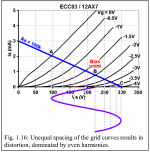Well, whether we agree with Merlin or not, if you draw a loadline for a 100k Rp and 300 V B+ on a set of 12AX7 curves, there is no arguing the fact that the thing won't saturate below 100 volts - or that twiddling bias for maximum unclipped output headroom puts the anode voltage somewhere in the general vicinity of 200 - 225 volts (and not B+/2, which is 150 volts.)
The attached image is from Blencowe's book.
-Gnobuddy
The attached image is from Blencowe's book.
-Gnobuddy
Attachments
Absolutely, yes, this is intended for use with electric guitar. Not valve Hi-Fi.Probably good for a Guitar, but not for Hi Fi?
To be honest, I don't at all understand the point of valve Hi-Fi this side of, say, 1980, by which time transistor amps were doing a vastly better job of accurately reproducing an audio signal (which is the goal of Hi-Fi.)
From my point of view, what valves do best, is distort guitar signals in a way that - by pure coincidence - enhances the overall sound of an otherwise lacklustre instrument. Which happens to be the only musical instrument I have any competency with.
In other words, we electric guitarists fiddle with valves, because we envy the rich timbre of traditional instruments like cellos and saxophones, which is is sadly quite lacking in solid-body electric guitars. Freudian compensation at its best...
-Gnobuddy
- Status
- This old topic is closed. If you want to reopen this topic, contact a moderator using the "Report Post" button.
